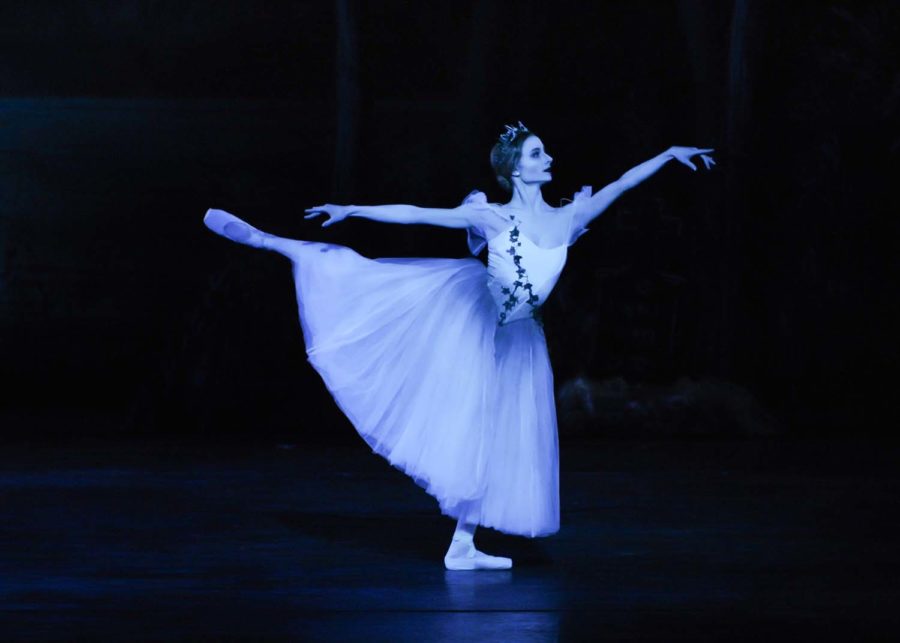“Giselle” kicks off Pittsburgh Ballet Theatre’s 50th season
Rich Sofranko/Pittsburgh Ballet Theatre
The Pittsburgh Ballet Theatre opened its 50th anniversary season with its production of “Giselle.”
October 29, 2019
Audience chatter died down as a warm yellow light cast a fall glow on a woodland cottage. A group of men and women seemed to float across the stage as they danced to a melodic orchestra.
This year, the Pittsburgh Ballet Theatre opened its 50th season at the Benedum Center Downtown with “Giselle,” one of five ballets they will perform this year. The show was the last for longtime PBT member Luca Sbrizzi. “Giselle” tells the story of a maiden who died of heartbreak. This wordless performance is intense — definitely not for the viewer looking for a relaxing evening.
At the beginning of the show, the huntsman Hilarion arrives and leaves pheasants for Giselle. He is madly in love with the beautiful maiden but leaves to join the village at the harvest festival. Mysterious Count Albrecht visits the cabin disguised as a peasant to be able to be close to Giselle. She is deeply in love with Albrecht and that is demonstrated in her joyful, almost childlike, dancing when he appears.
The scene of Giselle and Albrecht interacting with the others in the village parallels Belle’s village interaction in the beginning of Disney’s “Beauty and the Beast.” Giselle is dressed in a baby blue dress with her hair done up in a bun. The villagers standing around Giselle are clothed in earth tones of orange, gold and dark green. The blue to earth tone color contrast clearly singles out Giselle as the protagonist. The viewer who goes into this show blind will expect to see a fairy tale carried out, but will soon learn this is not the case.
Giselle invites villagers to join her in a merry dance at the harvest festival when her mother, Berthe, reminds her to pace herself because she has a weak heart. This warning triggers a vision from Berthe, where she sees her daughter die and become a Wili — the ghost of a young woman that died of a broken heart.
Giselle, like any rebellious teen, ignores her mother and literally dances her heart out for the Prince of Courland and his daughter when they arrive at the village festival. After her performance, Giselle descends into madness. She rips her hair out of its tight bun and throws herself on the stage. She wildly grabs at the air and tries to dance with other villagers but they are too scared. Berthe and Hilarion try to comfort her but it is no use, and she dies because of her weak heart.
The original production was first performed in 1841, when women were often portrayed as frail and delicate. PBT’s production does these themes justice, but is disappointing to a modern audience that a woman’s strong emotions lead to her downfall.
The portrayal of madness also seems out-of-place nowadays. The scene depicts a woman struggling to cope with internal anguish — a form of frustration that was apparently not emotionally sustainable at the time of the ballet’s creation. In a modern retelling, maybe Giselle’s romantic status would not be as closely tied to her fate.
Giselle’s death concludes Act I, which was long and dragged on. During the village celebration, there were several solo performances and various group dances that did not further the plot. Every time a group or solo performance concluded the audience would clap, immediately followed by yet another new and different dance number, which got repetitive and seemed unnecessary.
After intermission, the stage opened to a bog setting, a blue light and fog covering the stage floor. The cottage from the last scene was removed and replaced with a mound. This is Giselle’s grave and Myrtha, Queen of the Wilis, assembles her followers to bring Giselle into the sisterhood.
Hilarion visits Giselle’s grave to mark it with a cross. He is scared away by the Wilis, allowing Albrecht to pay his respects. He kneels and gives prayer, placing lilies on the grave. Albrecht blames himself for Giselle’s death because his engagement to the Prince of Courland’s daughter caused the stress that ultimately strained her heart and ended her life. He has lost direction now that she’s gone.
For a first-time viewer, this is a long and depressing piece, but it’s possible that a seasoned ballet attendee would appreciate the technique and acting necessary to portray the story. Not only does the main character die in the first act, she dies of sadness. From the time Giselle is introduced until her death, she doesn’t do much on stage — instead, the space is occupied by group dances and solo dances by other performers. There definitely did not need to be so many group dances, it just felt like filler content that did nothing for the story.
The only upside was the seasonality of the ballet. Playing the weekend before Halloween must have been attractive since half the performance is done by ghosts.








